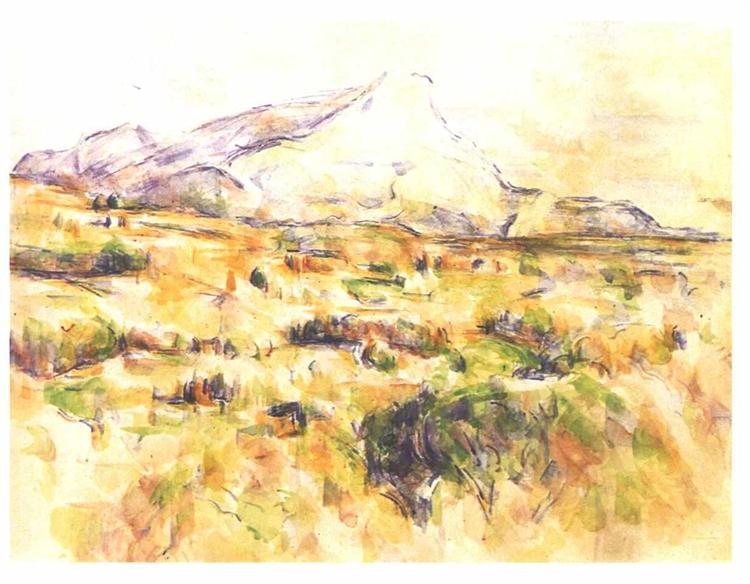Descrizione
L'opera "Mont Sainte-Victoire" di Paul Cézanne, dipinto nel 1902, è un'impressionante testimonianza dell'abilità e della visione dell'artista, nonché una pietra miliare fondamentale sulla strada per la modernità nell'arte. Questo paesaggio, che rappresenta la famosa montagna situata nel sud della Francia, è più che una semplice rappresentazione dell'ambiente naturale; È un'esplorazione della forma, della luce e del colore, caratteristiche essenziali dello stile di Cézanne.
Dal primo sguardo, la composizione rivela una struttura geometrica che sembra anticipare gli sviluppi nell'arte del ventesimo secolo. La montagna, con i suoi piani di colore e contorni definiti, funge da asse centrale della vernice. Cézanne usa la tecnica di colore per creare un senso di profondità, usando una tavolozza che varia da blu e verde a occhia e toni terrificanti. Questa varietà cromatica non solo porta la luminosità sulla scena, ma invita anche lo spettatore a immergersi nell'ambiente che circonda la montagna. Le pennellate sono visibili e dinamiche, fornendo una sensazione quasi tattile alla superficie pittorica.
Il paesaggio è strutturato attraverso un uso distintivo della prospettiva, in cui Cézanne decompone le forme naturali nei componenti di base, offrendo allo spettatore una visione poliedrica della realtà. Il trattamento della luce è un altro aspetto vitale di questo lavoro; I toni nel cielo si trasformano, riflettendo l'atmosfera e il tempo, suggerendo un momento di contemplazione immateriale. Puoi vedere una sottile transizione nel cielo da intense sfumature più calde, il che suggerisce un'ora del giorno specifica e, allo stesso tempo, evoca una sensazione di eternità.
Nella parte inferiore della composizione, ci sono i campi coltivati e gli alberi che incorniciano la vista della montagna. Cézanne riesce a rappresentare la relazione tra uomo e natura attraverso l'inclusione di questi elementi. Tuttavia, è importante notare che in questo dipinto non ci sono figure umane, che rende la montagna eretta quasi sola, come entità trascendentale che domina il paesaggio. Attraverso questa assenza di personaggi, l'artista sembra sottolineare l'immensità e la permanenza della natura di fronte alla transitorie dell'esistenza umana.
"Mont Sainte-Victoire" è una delle molteplici rappresentazioni che Cézanne ha realizzato in questo paesaggio iconico e ognuno di essi rivela diversi aspetti della sua evoluzione come artista. Cézanne è noto per il suo desiderio di abbattere le forme e concentrarsi sulla struttura sottostante degli oggetti, che gli ha guadagnato un precursore del cubismo. La sua ricerca della verità nella rappresentazione della natura si riflette in questo lavoro, in cui la montagna diventa una metafora di una realtà più profonda, il desiderio di comprendere l'essenza stessa della percezione.
In conclusione, "Mont Sainte-Victoire" di Cézanne non è solo un dipinto di un paesaggio, ma una pietra miliare nella storia dell'arte che segna un cambiamento nel modo di vedere e rappresentare il mondo. Il lavoro incapsula la visione innovativa di Cézanne e la sua capacità di unire la fedele rappresentazione della natura con un approccio soggettivo ed emotivo. La montagna, a sua maestà, rappresenta un simbolo della ricerca di bellezza e verità in natura, un problema che risuonerà nell'arte per gli anni a venire. Quando osserviamo questo lavoro, siamo invitati a partecipare a un'esperienza contemplativa, in cui la natura viene rivelata nella sua purezza e dove Cézanne ci offre un nuovo modo di interpretare la realtà che ci circonda.
KUADROS ©, una famosa vernice sul muro.
Dipinti ad olio fatti a mano, con la qualità degli artisti professionisti e il distintivo sigillo di KUADROS ©.
Servizio di riproduzione delle immagini con garanzia di soddisfazione. Se non sei completamente soddisfatto della replica del tuo dipinto, rimborsiamo i tuoi soldi al 100%.

